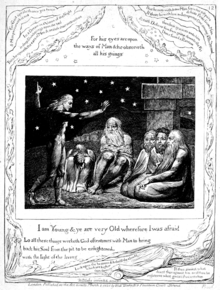Life of William Blake (1880), Volume 2/Prose writings/Note upon Blake's Engraved Designs
ENGRAVED DESIGNS BY BLAKE.
THE BOOK OF JOB.
TWENTY-ONE PHOTO-INTAGLIOS FROM THE ORIGINALS.
ENGRAVED DESIGNS BY BLAKE.
The aid of the photo-intaglio process has been called in to give the whole Job series as a thorough and important example of Blake's style. These photo-intaglios are, of course, line for line, and minutest touch for touch, the counterparts of their originals. They are smaller, but on the whole they may be safely put forward as giving a very sufficient idea of these, quite complete, indeed, in many of the most essential respects; and considering that the original publication is a rare and high-priced book, its reproduction here is a very valuable addition to our table of contents.
Quite as valuable, though still in another way not quite perfect, are the original plates of the Songs also given. These were recovered by Mr. Gilchrist, being the only remnant of the series still in existence on copper; the rest having, it is believed, been stolen after Blake's death, and sold for old metal. They are, therefore, as absolutely the originals as those appearing in the copies printed by Blake; and the reason why they must still be pronounced imperfect is that they were intended as a mere preparation for colouring by hand, as has been explained in the Life; while, being here necessarily given without the colour, they cannot be said to embody Blake's intention in producing them. Much which may here seem unaccountably rugged and incomplete is softened by the sweet, liquid, rainbow tints of the coloured copies into a mysterious brilliancy which could never have been obtained over a first printing of a neater or more exact kind; body colour as well as transparent colour being used in the finishing. However, there will be no doubt among those who love Blake's works as to the advisability of including them here even in the rough; and indeed, to any observer of poetic feeling, it is but the first glance at them which can prove really disappointing. Abundant beauty remains, even without the colour, in the wealth of lovely ever-varying lines, and plentiful overgrowth from the very heart of the painter, springing and clinging all round the beautiful verses. No littleness here because the scale of work is a small one. Almost any one of these pages might be painted, writing and all, on a space twenty feet high, and leave nothing to be desired as a grand decorative work.
On comparing these Plates with the fac-similies of designs belonging to the same class of Blake's works which are contained in the first volume, it will be at once apparent that the latter are generally extremely successful as reproductions of his style. His work of other kinds, more dependent on engraving in lines, was far more difficult to deal with by the process adopted; but everywhere the aim has been towards the utmost fidelity, whether the fac-simile was on the exact scale of the original or not.
In concluding the last of the brief prefatory notes to the various sections of this second volume, the writer of them believes he may trust not only to have expressed his own views on the matters to which they relate, but that these are also in harmony with the intentions and fully-matured plans of his friend the author of the Life. He had had many conversations with Mr. Gilchrist regarding the completion of this cherished work; and must have undertaken this slight supplementary task with a still heavier heart, had he not been sure that he agreed with the author of the work in all points concerning its subject, and that there was no danger of any opinion being expressed in the few closing passages, which he would unwillingly have endorsed. It may be said on this last page that, at least, neither love of Blake in its author, nor love of its author in those on whom the issuing of his work devolved, has been wanting to make it a true memorial of both.
[D. G. R.]




















